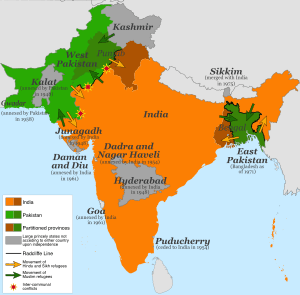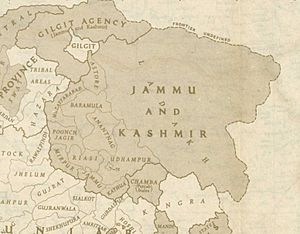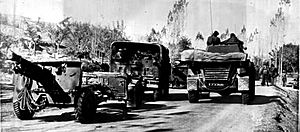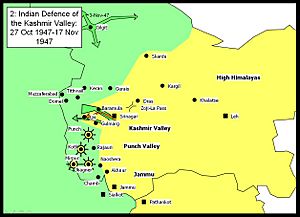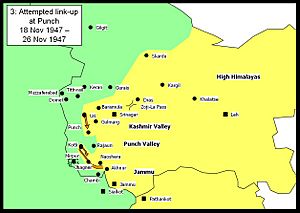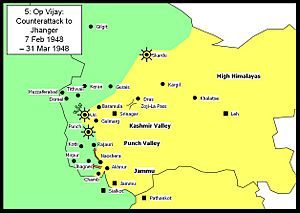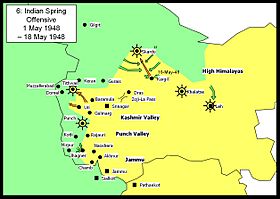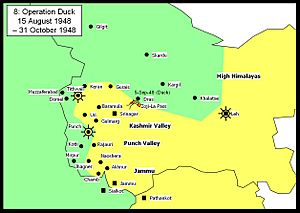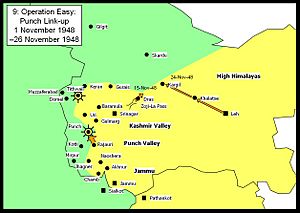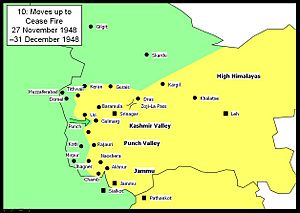Indo-Pakistani War of 1947–1948 facts for kids
Quick facts for kids Indo-Pakistani War of 1947–1948 |
|||||||||
|---|---|---|---|---|---|---|---|---|---|
| Part of the Indo-Pakistani conflicts | |||||||||
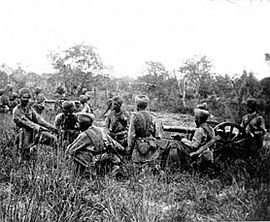 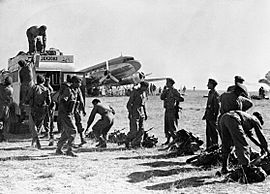 Indian (top) and Pakistani (bottom) soldiers during the 1947–1948 war |
|||||||||
|
|||||||||
| Belligerents | |||||||||
|
|
||||||||
| Commanders and leaders | |||||||||
| Casualties and losses | |||||||||
| 1,103 army deaths 1,990 J&K forces killed or missing 32 RIAF members 3,154 wounded Total military casualties: 6,279 |
6,000 killed ~14,000 wounded Total military casualties: 20,000 |
||||||||
| Conflict began when Pashtun tribesmen and Tanoli from Pakistan invaded the princely state of Jammu and Kashmir, prompting the armies of India and Pakistan to get involved shortly afterwards. | |||||||||
The Indo-Pakistani War of 1947–1948, also known as the First Kashmir War, was a conflict between India and Pakistan. It took place from 1947 to 1948 over the region of Jammu and Kashmir. This was the first of several wars between these two nations, which had just gained independence.
The war began when tribal fighters from Pakistan invaded Jammu and Kashmir. They aimed to take control of the region before its ruler could decide to join India. The outcome of this war still affects the relationship between India and Pakistan today.
Hari Singh, the ruler (Maharaja) of Jammu and Kashmir, was dealing with a local uprising. On October 22, 1947, tribal militias from Pakistan crossed into his state. These groups and other Pakistani forces tried to capture the capital city of Srinagar. However, they stopped in Baramulla to loot, which slowed their advance.
Maharaja Hari Singh asked India for help. India agreed, but only if he officially joined his state with India. The war started with the local forces of Jammu and Kashmir fighting the tribal militias. After the state joined India on October 26, 1947, Indian troops arrived in Srinagar by air. British officers initially did not want Pakistani troops to join the fight. But in 1948, Pakistan's army officially entered the war. The fighting lines eventually became what is now known as the Line of Control. A ceasefire was declared on January 1, 1949.
Contents
How Kashmir Became a State
Before 1815, the area known as "Jammu and Kashmir" was made up of 22 small independent states. These states were ruled by different kings. After the Mughal Empire weakened, these hill states came under the control of the Sikhs.
In 1846, after a war, the Sikhs gave up the Kashmir region. The British East India Company then allowed Gulab Singh, a Dogra ruler, to buy Kashmir from the Sikhs. Gulab Singh became the first Maharaja of the new princely state of Jammu and Kashmir. His family ruled this large state until India became independent in 1947.
India and Pakistan Become Independent
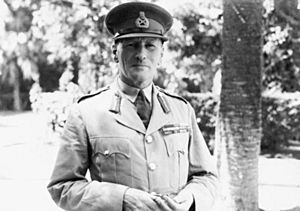
In 1946–1947, many Muslims in India wanted a separate country for themselves. This led to the decision on June 3, 1947, to divide British India into two separate nations: Pakistan (for Muslim-majority areas) and India (for the rest).
The provinces of Punjab and Bengal, which had many Muslims, were also divided. About 11 million people moved between the two parts of Punjab. Sadly, around 1 million people died in the violence between different religious groups. Jammu and Kashmir, being next to Punjab, was directly affected by these events.
The British originally planned to transfer power in June 1948. But fearing more violence, they moved the date to August 15, 1947. This gave only six weeks to prepare for the division. British officers stayed to help manage the armed forces for a while. Field Marshal Claude Auchinleck was in charge of the overall administration for both new countries.
The presence of British officers on both sides made the 1947 war unusual. The British commanders of the Indian and Pakistani armies were in daily contact. They tried to limit the fighting.
Jammu and Kashmir's Situation in 1947

When India and Pakistan became independent, the British rule over the princely states ended. The rulers of these states were advised to join either India or Pakistan. Maharaja Hari Singh of Jammu and Kashmir decided not to join either country at first. He thought that the state's Muslim majority might not like joining India, and its Hindu and Sikh minorities might be unsafe if it joined Pakistan.
In 1947, Jammu and Kashmir had many different groups of people. The Kashmir Valley had mostly Muslims. The Jammu province had a mix of Hindus and Muslims. The Ladakh region had many Buddhists and Muslims. The Gilgit area in the north was almost entirely Muslim.
The main political group in the Kashmir Valley, the Jammu & Kashmir National Conference, supported secular politics. They were allied with the Indian National Congress and seemed to favor joining India. However, Muslims in the Jammu province supported the All Jammu and Kashmir Muslim Conference, which wanted to join Pakistan. Hindus in Jammu wanted to join India directly. Given these different views, the Maharaja's choice to stay independent seemed wise at first.
Pakistan's Plan: Operation Gulmarg
Indian military sources say that the Pakistani Army had a plan called Operation Gulmarg. This plan was supposedly put into action around August 20, 1947. The plan involved recruiting 20 "lashkars" (tribal militias), each with 1,000 Pashtun tribesmen. They were to be armed and ready to cross into Jammu and Kashmir by October 22.
These groups planned to attack the Kashmir Valley and join rebels in other areas like Poonch. The plan included details for military leaders and weapons. Records show that a Pakistani cavalry regiment was briefed about the invasion plan in late August. They were tasked with getting weapons for the "freedom fighters."
Pakistani sources deny that Operation Gulmarg ever existed. However, many Pashtun tribes were involved in the invasion of Kashmir on October 22.
Uprising in Poonch
In August 1947, problems started in Poonch. Poonch was a special area ruled by a different branch of the Maharaja's family. People there felt taxes were too high. Many men from Poonch had served in the British Indian Army during World War II. After the war, they were discharged with their weapons.
In June, people in Poonch started a "No Tax" campaign. The Maharaja then ordered that all soldiers in the region be disarmed. This, along with high taxes and no jobs, led to a rebellion. Local Muslim leaders used this unrest to push for Poonch to join Pakistan.
Reports from the state government said that rebels attacked state troops. But Muslim leaders said that hundreds of people were killed in Bagh and that the Maharaja's army acted very harshly.
Pakistan's Actions and Maharaja's Decisions
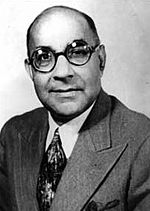
Historians believe the Maharaja decided by April 1947 that he would join India if he couldn't stay independent. The rebellion in Poonch likely made him nervous. On August 11, he fired his prime minister and appointed a new one. On August 25, he invited Justice Mehr Chand Mahajan to become his prime minister.
On the same day, the Muslim Conference warned Pakistan's Prime Minister, Liaquat Ali Khan, that Kashmir might be lost to them. Pakistan then cut off important supplies to Kashmir, like petrol and salt. They also stopped trade and train services to Jammu.
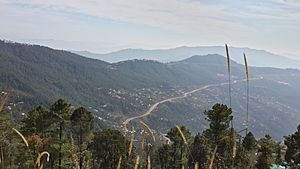
Meanwhile, a rebel leader named Sardar Muhammad Ibrahim Khan went to West Punjab and set up a base in Murree. From there, rebels tried to get weapons for the uprising. A Pakistani Army officer, Colonel Akbar Khan, helped them get 4,000 rifles from army stores. He also wrote a plan for an "Armed Revolt inside Kashmir."
On September 12, Pakistan's Prime Minister met with Colonel Akbar Khan and other politicians. They approved plans to mobilize tribal groups from the border regions.
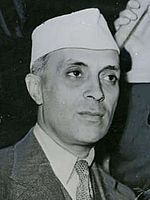
The Maharaja was in a difficult position with the rebellion and Pakistan's blockade. He agreed to join India but asked for more time. India's Prime Minister, Jawaharlal Nehru, said that India would only accept the accession if the people supported it. He also demanded that Sheikh Abdullah, a popular leader, be released from prison and involved in the state's government. Sheikh Abdullah was released on September 29.
Nehru stated that any dispute over territory should be decided by a vote (referendum or plebiscite) of the people. He told Liaquat Ali Khan about this policy on October 1.
Fighting in Poonch and Mirpur
Armed rebellion began in the Poonch district in early October 1947. The fighters were former soldiers, Pakistani Army soldiers on leave, and other volunteers. The first major clash happened on October 3–4, 1947. The rebels quickly took control of most of the Poonch district. The state forces in Poonch city were surrounded.
In the Mirpur district, border posts were captured by rebels around October 8. Some Muslim officers from the state forces joined the rebels. Radio messages between the fighting groups were handled by the Pakistan Army.
Kashmir Joins India
After the rebellions and the tribal invasion, the Maharaja asked India for military help. India said Kashmir must officially join India to receive assistance. The Maharaja agreed, and the Government of India accepted Kashmir's accession. Indian troops were then sent to defend the state. Volunteers from the Jammu & Kashmir National Conference helped the Indian Army fight the invaders.
Pakistan did not accept Kashmir joining India. Pakistan's Governor General, Mohammad Ali Jinnah, ordered his Army Chief, General Douglas Gracey, to send Pakistani troops to Kashmir. However, the Indian and Pakistani armies were still under a joint British command. Field Marshal Auchinleck convinced Jinnah to withdraw his order. Since Kashmir was now legally Indian territory, British officers could not take part in a war between the two new countries.
The Pakistan Army provided weapons and supplies to the rebel forces, calling them the "Azad Army." Pakistani Army officers who were "on leave" and former officers from the Indian National Army were recruited to lead these forces.
In May 1948, the Pakistan Army officially entered the conflict. They planned to push towards Jammu and cut off Indian supply lines. In Gilgit, local forces called the Gilgit Scouts, led by a British officer, rebelled and took over. They declared that Gilgit would join Pakistan. They also got help from forces from Chitral, another princely state that had joined Pakistan.
Key Stages of the War
First Invasion
On October 22, the Pashtun tribal attack began in the Muzaffarabad area. The state forces there were quickly defeated, and some Muslim state forces joined the attackers. This opened the way to the capital. Many active Pakistani Army soldiers were among the raiders, pretending to be tribesmen. They also received logistical support from the Pakistan Army. Instead of moving quickly to Srinagar, the invaders stopped to loot the captured towns. In the Poonch valley, state forces were surrounded in towns.
Reports show that the Pakistani tribal groups killed many Hindu and Sikh civilians in Jammu and Kashmir.
India Defends Kashmir Valley
After Kashmir joined India, India flew troops and equipment to Srinagar. These Indian forces, led by Lt. Col. Dewan Ranjit Rai, strengthened the state forces. They set up defenses and pushed back the tribal forces from the city's edges. A key defense was at Badgam, where they held the capital and airfield overnight against great odds. Indian armored cars also helped in the Battle of Shalateng. The defeated tribal forces were chased back to Baramulla and Uri, which were then recaptured.
In the Poonch valley, tribal forces continued to surround state forces. In Gilgit, the state paramilitary forces, the Gilgit Scouts, joined the invading tribal forces. This gave them control of the northern part of the state. Forces from Chitral also joined the tribal forces.
Efforts to Reach Poonch and Fall of Mirpur
Indian forces stopped chasing the tribal groups after retaking Uri and Baramulla. They sent a relief column south to help Poonch. Although this column reached Poonch, the siege could not be fully lifted. Another column reached Kotli and rescued its troops, but had to abandon the town. Meanwhile, Mirpur was captured by tribal forces on November 25, 1947, with help from Pakistan's cavalry. This led to many Hindu women being taken into Pakistan.
Fighting in Jhanger, Naoshera, and Uri
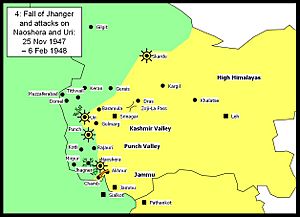
Tribal forces attacked and captured Jhanger. They then attacked Naoshera and Uri several times but failed to capture them. In the south, a small Indian attack secured Chamb. At this point, the front lines began to become more stable as India got more troops.
Indian Counterattack at Jhanger
Indian forces launched a counterattack in the south, taking back Jhanger and Rajauri. In the Kashmir Valley, tribal forces kept attacking the Uri garrison. In the north, Skardu was surrounded by the Gilgit Scouts.
Indian Spring Offensive
The Indians held Jhanger against many counterattacks, which were increasingly supported by regular Pakistani forces. In the Kashmir Valley, the Indians attacked and recaptured Tithwail. The Gilgit Scouts advanced well in the High Himalayas, surrounding Leh and capturing Kargil. They also defeated an Indian group trying to reach Skardu.
Operations Gulab and Eraze
The Indians continued their attacks in the Kashmir Valley, moving north to capture Keran and Gurais (Operation Eraze). They also stopped a counterattack aimed at Tithwal. In the Jammu region, the forces surrounded in Poonch managed to break out and connect with the outside world again for a short time. The Kashmir State army defended Skardu from the Gilgit Scouts, stopping their advance towards Leh. In August, the Chitral Scouts and Chitral Bodyguard surrounded Skardu and captured it with artillery. This allowed the Gilgit Scouts to push further into Ladakh.
Operation Bison
During this time, the front lines became more stable. The siege of Poonch continued. An Indian attack to capture Zoji La pass failed at first. This attack, originally called Operation Duck, was renamed Operation Bison. Light tanks were brought in pieces through Srinagar and reassembled. Engineers built a jeep track across Zoji La. A surprise attack on November 1 by Indian forces with tanks and artillery forced the pass. They pushed the tribal and Pakistani forces back to Matayan and then Dras. On November 24, Indian troops from this attack met with Indian troops advancing from Leh at Kargil. The Pakistani forces eventually retreated north towards Skardu.
The Pakistanis attacked Skardu on February 10, 1948, but were pushed back. The Skardu Garrison was attacked continuously for three months. Colonel Sher Jung Thapa and his 250 men defended Skardu for six months without help. On August 14, Thapa had to surrender Skardu to the Pakistani Army after a year-long siege.
Operation Easy; Poonch Link-up
The Indians began to gain the upper hand in all areas. Poonch was finally relieved after being surrounded for over a year. The Gilgit forces in the High Himalayas were defeated. The Indians chased them as far as Kargil but had to stop due to supply problems. The Zoji La pass was taken using tanks (which was thought impossible at that height), and Dras was recaptured.
Cease-fire
After long talks, both countries agreed to a cease-fire. The terms were set by a UN Commission on August 13, 1948, and accepted on January 5, 1949. Pakistan had to withdraw its regular and irregular forces. India was allowed to keep a small number of troops to maintain order. After these conditions were met, a vote (plebiscite) was supposed to be held to decide the future of the region. However, disagreements about removing troops meant the vote never happened, and the cease-fire line became permanent.
What Happened After the War
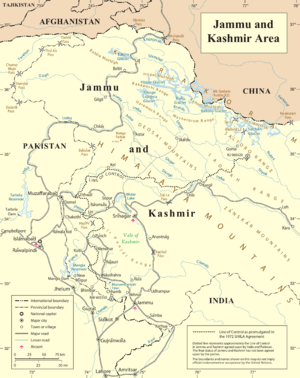
India lost 1,104 soldiers and had 3,154 wounded. Pakistan lost about 6,000 soldiers and had 14,000 wounded. Most experts agree that India won because it successfully defended most of the disputed territory.
India gained control of about two-thirds of Jammu and Kashmir. This included the Kashmir Valley, the Jammu province, and Ladakh. Pakistan controlled one-third of the state: three western districts (now called Azad Jammu and Kashmir) and the northern areas, including Gilgit and Baltistan (now called Gilgit-Baltistan).
After two more wars in 1965 and 1971, the borders changed only a little. After the last war, India and Pakistan signed the 1972 Simla Agreement. This agreement turned the cease-fire line into a Line of Control and stated that neither country would use force across it.
Military Awards
After the war, the Indian Army received 11 "battle honours" and one "theatre honour" for their brave actions. Some notable ones include:
- Jammu and Kashmir 1947–48 (theatre honour)
- Gurais
- Kargil
- Naoshera
- Punch
- Rajouri
- Srinagar
- Tithwal
- Zoji La
Many soldiers and officers also received the highest bravery awards from their countries.
- India
- Major Som Nath Sharma (awarded after his death)
- Lance Naik Karam Singh
- Second Lieutenant Rama Raghoba Rane
- Naik Jadu Nath Singh (awarded after his death)
- Company Havildar Major Piru Singh Shekhawat (awarded after his death)
- Pakistan
- Captain Muhammad Sarwar
Images for kids
See also
 In Spanish: Guerra indo-pakistaní de 1947 para niños
In Spanish: Guerra indo-pakistaní de 1947 para niños
- Siege of Skardu
- Rann of Kuch War
- Battle of Badgam
- Indo-Pakistani War of 1965
- Indo-Pakistani wars and conflicts
- Kargil War
- Brigadier Mohammad Usman
- Siachen war
- Sino-Indian War
- List of wars between democracies


